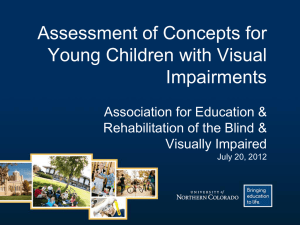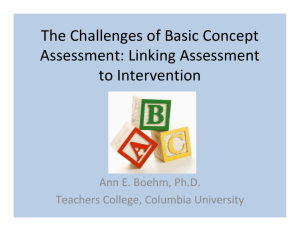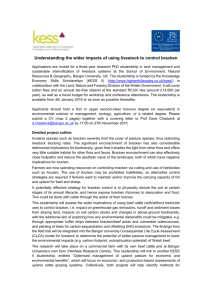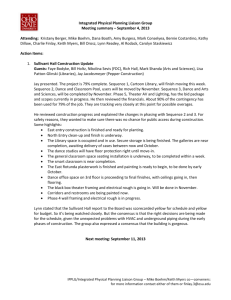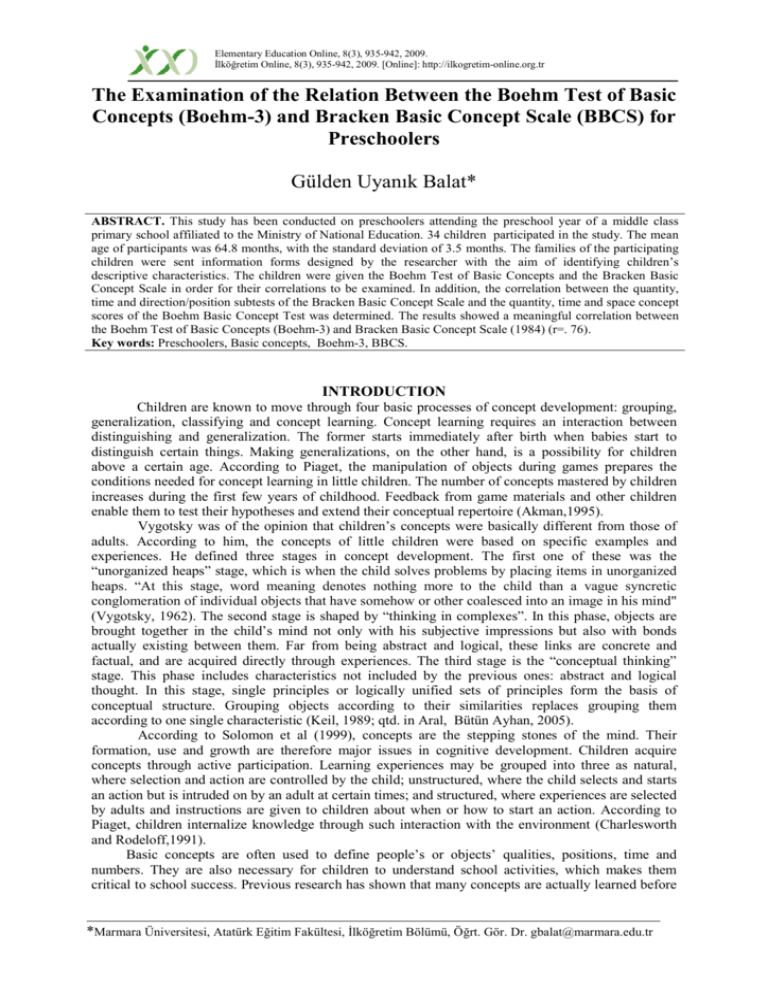
Elementary Education Online, 8(3), 935-942, 2009.
lkö retim Online, 8(3), 935-942, 2009. [Online]: http://ilkogretim-online.org.tr
The Examination of the Relation Between the Boehm Test of Basic
Concepts (Boehm-3) and Bracken Basic Concept Scale (BBCS) for
Preschoolers
Gülden Uyan+k Balat*
ABSTRACT. This study has been conducted on preschoolers attending the preschool year of a middle class
primary school affiliated to the Ministry of National Education. 34 children participated in the study. The mean
age of participants was 64.8 months, with the standard deviation of 3.5 months. The families of the participating
children were sent information forms designed by the researcher with the aim of identifying children’s
descriptive characteristics. The children were given the Boehm Test of Basic Concepts and the Bracken Basic
Concept Scale in order for their correlations to be examined. In addition, the correlation between the quantity,
time and direction/position subtests of the Bracken Basic Concept Scale and the quantity, time and space concept
scores of the Boehm Basic Concept Test was determined. The results showed a meaningful correlation between
the Boehm Test of Basic Concepts (Boehm-3) and Bracken Basic Concept Scale (1984) (r=. 76).
Key words: Preschoolers, Basic concepts, Boehm-3, BBCS.
INTRODUCTION
Children are known to move through four basic processes of concept development: grouping,
generalization, classifying and concept learning. Concept learning requires an interaction between
distinguishing and generalization. The former starts immediately after birth when babies start to
distinguish certain things. Making generalizations, on the other hand, is a possibility for children
above a certain age. According to Piaget, the manipulation of objects during games prepares the
conditions needed for concept learning in little children. The number of concepts mastered by children
increases during the first few years of childhood. Feedback from game materials and other children
enable them to test their hypotheses and extend their conceptual repertoire (Akman,1995).
Vygotsky was of the opinion that children’s concepts were basically different from those of
adults. According to him, the concepts of little children were based on specific examples and
experiences. He defined three stages in concept development. The first one of these was the
“unorganized heaps” stage, which is when the child solves problems by placing items in unorganized
heaps. “At this stage, word meaning denotes nothing more to the child than a vague syncretic
conglomeration of individual objects that have somehow or other coalesced into an image in his mind"
(Vygotsky, 1962). The second stage is shaped by “thinking in complexes”. In this phase, objects are
brought together in the child’s mind not only with his subjective impressions but also with bonds
actually existing between them. Far from being abstract and logical, these links are concrete and
factual, and are acquired directly through experiences. The third stage is the “conceptual thinking”
stage. This phase includes characteristics not included by the previous ones: abstract and logical
thought. In this stage, single principles or logically unified sets of principles form the basis of
conceptual structure. Grouping objects according to their similarities replaces grouping them
according to one single characteristic (Keil, 1989; qtd. in Aral, Bütün Ayhan, 2005).
According to Solomon et al (1999), concepts are the stepping stones of the mind. Their
formation, use and growth are therefore major issues in cognitive development. Children acquire
concepts through active participation. Learning experiences may be grouped into three as natural,
where selection and action are controlled by the child; unstructured, where the child selects and starts
an action but is intruded on by an adult at certain times; and structured, where experiences are selected
by adults and instructions are given to children about when or how to start an action. According to
Piaget, children internalize knowledge through such interaction with the environment (Charlesworth
and Rodeloff,1991).
Basic concepts are often used to define people’s or objects’ qualities, positions, time and
numbers. They are also necessary for children to understand school activities, which makes them
critical to school success. Previous research has shown that many concepts are actually learned before
*Marmara Üniversitesi, Atatürk E itim Fakültesi, lkö retim Bölümü, Ö rt. Gör. Dr. gbalat@marmara.edu.tr
Elementary Education Online, 8(3), 935-942, 2009.
lkö retim Online, 8(3), 935-942, 2009. [Online]: http://ilkogretim-online.org.tr
children start school, i.e. in the preschool years. Studies have also shown that children with learning
difficulties tend to face more difficulties when learning basic concepts and that insufficient learning
experiences during the preschool years may lead to differences in conceptual development in later
years. Boehm (2001) emphasizes the importance of exposing children to activities geared towards
minimizing the differences in concept learning and linguistic development.
Research has shown that many concepts are learned during the preschool years (Clark, 1983; de
Villiers and de Villiers, 1978; French and Nelson, 1985; qtd. in Boehm,2001). In these years, children
gradually learn basic concepts such as both, other and before. These basic concepts play an important
role in understanding course content and materials in the first grade. For instance, the teacher may ask
pupils to open both, find the other ball or wash their hands before eating. The assessment of children’s
mastery of basic concepts is often done through certain tests. In Turkey, for instance, the Boehm Test
of Basic Concepts (BTBC) and the Bracken Basic Concept Scale (BBCS) are commonly used in the
evaluation of children’s knowledge of basic concepts. BBCS has been correlated to several other tests.
Mcintosh, Wayland and Barnes (1995) reported a strong association (r = .80) between the BBCS Total
Test score and the DAS General Conceptual Ability (GCA) score. Likewise, a correlation of .91 was
found between the Bracken Basic Concept Scale and Stanford-Binet Intelligence Scale: Fourth Edition
(SB-IV), (Kuehn-Howell, Bracken 1992). Ryhner and Bracken (1988) showed low to moderate
correlations between standard scores from the Bracken Basic Concept Scale, the auditory
comprehension and verbal ability subscales of the Preschool Language Scale, and the Slossen
Intelligence Test.
Stainbauer and Heller (2006) gave preschoolers the Boehm Test of Basic Concepts and the
Stanford Achievement Test, Form W. The scores obtained in each subject area by the Stanford were
then correlated with those of the Boehm Test. The resulting coefficients suggested a strong correlation
between deficiencies in early concept learning as tested by the Boehm Test of Basic Concepts and
academic success in the second and third grades. These results indicated the Boehm Test of Basic
Concepts as an early predictor of school success. Boehm (2001) examined the validity of Boehm-3
with four different tests. She found correlations between Boehm-R (.61 to.96), Metropolitan
Achievement Test (.58 to .88), Metropolitan Readiness Test-sixth edition (.48 t0 .63) and Otis-Lennon
School Ability test- Seventh Edition (.45 to 68). Sarachan-Deily et al (1983) observed that among
kindergarten children, the Concept subtest of the DIAL was found to be highly correlated with the
BTBC, indicating the evaluation of similar abilities. Beech (1981), on the other hand, investigated the
concurrent validity of the Boehm Test of Basic Concepts (BTBC) by comparing it to two tests of
linguistic abilities (TACL and CELI) and five tests of cognitive abilities (Piagetian tasks). While the
strongest correlation of the BTBC was with the test of receptive language, correlations with Piagetian
tests were found to be moderate. It was thus concluded that the BTBC could be used as a general
estimate of cognitive ability.
The present study investigated the correlation between the Bracken Basic Concept Scale and
Boehm-3 for Turkish children.
METHOD
Sample
The participants were chosen randomly from among a total of 94 children attending the
preschool year of a primary school affiliated to the Ministry of National Education. A total of 34
children, 17 girls and 17 boys, participated in the study. The average age of children was 64.8 months,
with a standard deviation of 3.5 months. Twenty-four of the children had not received preschool
education formerly, 6 had been in preschool for one year, 2 had been in preschool for two years and
the remaining 2 for three years. Twelve participants were single children, 19 had one sibling, 1 had
two siblings and 2 had three siblings. Seventeen children were first-born, 15 were second-born, 1 was
third-born and 1 fourth-born. An examination of parents’ educational status showed that 5 mothers
were primary school graduates, 4 were secondary school graduates, 17 were high school graduates, 6
were university graduates, and 2 held graduate degrees. Six fathers, on the other hand, were primary
school graduates, 3 were secondary school graduates, 17 were high school graduates, 11 were
university graduates, and 3 held university degrees. The scales were implemented on children one by
one in an unstimulating room.
Elementary Education Online, 8(3), 935-942, 2009.
lkö retim Online, 8(3), 935-942, 2009. [Online]: http://ilkogretim-online.org.tr
Boehm Test of Basic Concepts (Boehm-3,2000)
Boehm Test of Basic Concepts (version year 2000) was developed by Ann E. Boehm.
The test can be applied to children attending kindergarten and second grade. The test consists
of a small booklet including 50 basic concepts, and its aim is to evaluate the children’s ability
levels on qualitative, environmental and characteristics of some concepts. Applications were
carried out individually. Each child was presented with the test material, directions were
given, and they were asked to choose the correct picture. Every correct answer is marked as “1”
and every wrong answer as ”0” (Boehm,2000). Boehm-3 has two parallel forms: Forms E and F. The
current study employed the former. The tests were administered in one session. Boehm-3 results may
be reported in raw scores, percent correct, performance ranges and percentiles. In this study, we used
raw and sub-test raw scores. The validity of the E form of the test for first grade Turkish
children (2002), and test retest reliability were calculated to be 879 (ICC) and Croncbach Alfa
.8626. Spearman-Brown reliability was calculated as .8290 (Uyan+k-Balat, 2003).
Bracken Basic Concept Scale (BBCS)
The Bracken Basic Concept Scale was used to evaluate the concept development of children
aged between 2.6 and 8. The scale has 11 sub-tests which cover the recognition of colour, letter,
number/counting, comparison, shape, direction/position, social/emotional concepts, size, texture and
material, quantity and time. Each child starts BBCS from the first item of each of the first five subtests and continues with these sub-tests until s/he fails consecutively in three items. The score obtained
by children on these five subtests is used to estimate the initial level of success that the child will
display in each of the remaining sub-tests. The starting items of the tests that range between 6 to 11 are
lettered from A to K. The child gets one point for every correct answer on each of the subtests. Every
correct answer is marked as “1” and every wrong answer as ”0” (Bracken, 1984). Since the letter “w”
does not exist in the Turkish alphabet, the letter “v” was used instead in the letter recognition test.
Likewise The Turkish currency unit of YTL was used in the questions related with the concept of
money in the sub-test on quantity.
FINDINGS
As shown in Table 1, the correlation between the results of the Boehm Test of Basic Concepts
(Boehm-3) and Bracken Basic Concept Scale is meaningful (p<.0001), thereby showing that both
tests may be used to assess the basic concept knowledge of preschoolers. Similarly, Boehm (2001b)
found that the correlation between Boehm–3 Preschool and Bracken Basic Concept Scale-Revised was
.80 for 3-year-olds and .73 for 5-year olds. It may be inferred from these results that both tests
measure many of the same aspects of the constructs of basic concepts.
Table 1.
Pearson’s Correlation between the Boehm Test of Basic Concepts and Bracken Basic Concept Scale
Bracken Basic Concept Scale
Boehm Test of Basic Concepts (BBCS)
(BTBC-3)
r=.756, p=.0001
Elementary Education Online, 8(3), 935-942, 2009.
lkö retim Online, 8(3), 935-942, 2009. [Online]: http://ilkogretim-online.org.tr
Table 2.
Pearson’s Correlation between the space, quantity and time concepts of the Boehm Test of Basic
Concepts and the direction-position quantity and time subtests of the Bracken Basic Concept Scale
Boehm Test of Basic
Concepts (BTBC)/ Bracken BTBCBasic Concept Scale (BBCS) Space
BTBCQuantity
BTBC- Space
BTBC- Quantity
0.583*** BTBC- Time
0.735*** 0.716***
BBCS- Direction-Position
0.552*** 0.672***
BBCS- Quantity
0.513**
0.680***
BBCS- Time
0.437*
0.656***
*** p<0.0001, ** p<0.001, * p<0.05 (2- tailed)
BTBCTime
BBCSDirection
-Position
BBCSQuantity
0.201
0.287
0.421*
0.746***
0.632***
0.748***
BBCS
Time
-
TheBoehm Test of Basic Concepts and the subtests of Bracken Basic Concept Scale were
investigated and a positive meaningful correlation varying between .421 and .746 was found. The only
instance where a meaningful correlation did not exist was between the time concept of the Boehm Test
of Basic Concepts and the direction-position and quantity subtests of the Bracken Basic Concept
Scale. However, a meaningful correlation at the level of .421 was found between the time concept of
the two tests.
DISCUSSION
The American National Research Council (2000) has identified three principles of learning based
on research and they recommend these to be incorporated into school curricula:
* The ideas and concepts that help children make sense of their environment develop at a very
young age. Children, however, are not empty vessels to be filled with new information; rather,
they build on their existing understandings. Learning is thus most effective when their
preconceptions are engaged. School curricula should build on children’s existing ideas.
* Expertise is not gained solely through factual knowledge and skills. More than these, it needs a
conceptual understanding to turn these facts and skills into “usable” knowledge. In mathematics,
for example, children need to develop more than just verbal counting skills and number
recognition; they need to grasp “quantity.” Similarly, emergent literacy requires more than the
mere recognition of letters. It requires an understanding of the concept of “representation”
involved in written words and illustrations. As the preschool years are a time when children are
rapidly developing skills and acquiring new knowledge, the importance of concepts may be
overlooked. Curricula should promote learning of concepts in addition to information and skills.
* Children can be taught to monitor their thinking in the form of learning strategies. These
“metacognitive skills” are naturally used by some children but curricula should incorporate efforts
to ensure that all children learn these skills deliberately.
In a similar vein to the American National Research Council, Ginsburg et al (1999) stated that
preschool curricula should have activities that include the following basic concepts or ideas of
mathematics:
Elementary Education Online, 8(3), 935-942, 2009.
lkö retim Online, 8(3), 935-942, 2009. [Online]: http://ilkogretim-online.org.tr
• Numbers; counting and meaning of numbers
• Shapes, identifying and constructing 2 and 3 dimensional shapes; understanding their properties
• Putting together and taking apart; promoting exploration of adding and subtracting, and relations
between sets and subsets
• Spatial relations; exploring relations such as in front of, behind, above, below, left-right which are
important to navigation
• Measurement; exploring quantity and physical attributes such as length, weight, temperature and
money
• Patterns and predictions; introducing patterns such as shapes, numbers, and sounds and
encouraging children to detect patterns for prediction.
These give us an idea of an optimal preschool curriculum. In Turkey, a preschool curriculum
has been designed by the Ministry of National Education’s General Directorate of Preschool
Education. Aimed at 36-72 month old children, this curriculum includes objectives and attainments
and is implemented by teachers who prepare annual and daily plans. The overall aim of this
integrative curriculum is to meet the pre-specified objectives and attainments throughout the
preschool years. In addition to the objectives, the General Directorate of Preschool Education has also
prepared a list of concepts that children should learn. The list includes but is not limited to the basic
relational concepts of numbers, colors, shapes, inside-outside, yesterday-today-tomorrow, half-whole,
even-odd, same-different-similar, and less-more.
Preschool curricula have many aims, one of which is to prepare children for primary
education. Appropriate assessment tools must be used to see how many of these concepts are attained
by children and whether they are able to learn these concepts which are needed in primary school.
Both Bracken Basic Concept Scale and Boehm Test of Basic Concepts are commonly used by
researchers in Turkey with the aim of assessing the conceptual knowledge of children.
Akman (1995), for instance, investigated the concept development of 40-69 month old
preschoolers with the aim of examining the effects of concept training. Using the Bracken Basic
Concept Scale, this study concluded that the training meaningfully contributed to the concept
development of children. Akman, pek and Uzun (1999) studied the concept development of six-year
old children in two different schools following two different curricula, and found no meaningful
difference. In another study, Akman, pek and Uyan+k (2000) used BBCS to assess the concept
development of preschoolers and reported a meaningful relationship between the subtests with respect
to children’s scores. In yet another study, Akman, Uyan+k and Uzun (2000) found a meaningful
difference between the concept development of six year-olds living with their families and in foster
homes.
Ar+ et al (2000) assessed the concept development of four to six-year-olds with BBCS and
found a difference between the concept development of children who received preschool education
and those who did not. Studies conducted by Uyan+k Balat (2003) and Uyan+k Balat & Artan (2004)
by using BTBC-3 assessed the concept knowledge of 513 children with respect to the variables of
living in a foster home versus living with their family, gender, socio-economic level, and parents’
education level. They found a meaningful difference between the basic relational concept scores of
children from different socio-economic backgrounds.
In a different study, Uyan+k-Balat and Güven (2006) studied the concept development of first
and second-graders with respect to having received preschool education or not and living with their
family or in a foster home, and found a meaningful relationship between the duration of preschool
education and children’s concept scores. In the same study, while no meaningful difference was found
between the concept scores of first graders living in a foster home and with their family, the difference
was meaningful in the second grade.
Üstün and Akman (2003) used BBCS to assess the concept development of three-year-old
children who were and were not receiving preschool education and reported a meaningful difference
between groups. U urtay-Üstünel (2007) conducted the validity and reliability studies of the Bracken
Bracken Basic Concept Scale – revised version for use with Turkish children.
As shown through these studies, both Boehm Test of Basic Concepts and Bracken Basic
Concept Scale are commonly used in studies on the concept development of Turkish children. This
Elementary Education Online, 8(3), 935-942, 2009.
lkö retim Online, 8(3), 935-942, 2009. [Online]: http://ilkogretim-online.org.tr
study does not aim to suggest that these two tests should be used interchangeably. Indeed, when asked
the main difference between his test and the Boehm Test of Basic Concepts in an interview, Bracken
(2003) replied that his test could be implemented individually, assessed more than 300 basic concepts
in eleven subtests, and could be used for scanning, clinical diagnosis, curriculum evaluation, or speech
and language assessment. He also stated that the Boehm Test of Basic Concepts (1986) may be used
individually or in groups, may be employed to assess 50 basic concepts for preschool, first and second
grades, and that the preschool form may be used to assess 26 relational concepts starting from age 2
(Bracken, Shaughnessy,2003).
In sum, this study has found that the Boehm Test of Basic Concepts (Boehm-3) and the
Bracken Basic Concept Scale are meaningfully related and that both tests may be used in assessing
children’s basic concept knowledge. Researcher should consider needs in choosing one test over the
other. They should base their decisions on a number of factors such as an evaluation of the children,
curriculum, speech and language, risks with respect to learning difficulties, and clinical evaluations.
REFERENCES
Akman, B.(1995) An examination of the effects of concept training in the concept development of 40-69 month
old preschoolers, H.U. Child Health and Education Program, Unpublished doctoral dissertation, Ankara.
Akman, B., pek, A., Uyan+k, G. (1999) Evaluation of Concept Development in Children of Age 6 Attending
Kindergartens with Different Curricula, European Conference on Quality in Early Childhood Education, 9th
EECERA CONFERENCE, Helsinki, Finland, 1-4 September
Akman, B., pek, A., Uyan+k, G. (2000) Examination of the conceptual development of children at six years of
age attending kindergarten, International Journal of Early Years Education, 8(3), 227-234.
Akman, B., Uyan+k, G., Uzun, D. (2000) Concept Development in 6 Year Old Children: Orphans Children with
Their Families, Complexity Diversity and Multiple Perspectives in Early Childhood, 10th EECERA
CONFERENCE, London, England, 29 August-1 September.
Akman, B. Üstün, E. (2003) Concept development in 3-year-old children, Hacettepe University Journal of
Education Faculty, 24,137-141.
Aral, N. Bütün Ayhan, A. (2005) An examination of computer assisted instruction in the concept development of
six-year-old preschoolers, Ankara University School of Home Economics Scientific Research and
Investigations, 10, Ankara.
Ar+, M., Üstün, E., Akman,B. (1994). A comparison of concept development in 4-6 year old children who attend
preschool and who do not, 10 Ya-Pa Seminar for Making Preschool Education More Widespread, Ya-Pa
Publications, Istanbul, May p.197-215.
Balat, Uyan+k, G. Güven, Y. (2006) A comparison of the concept development of 1st and 2nd graders with respect
to having received preschool education or not and staying with their family or in a foster home, Educational
Science: Theory & Practice, 6(3), 923-945.
Balat Uyan+k, G., Artan . (2004) An examination of basic concept knowledge related to school readiness of sixyear-olds who live in foster homes and with their families, OMEP World Council Meeting and Conference,
5-11 October 2003, Proceedings, Ya-Pa Publications, Istanbul.
Balat Uyan+k G. (2003) A comparison of basic concept knowledge related to school readiness of six-year-olds
who live in foster homes and with their families, Hacettepe University, Institute of Health Sciences, Child
Development and Education, Unpublished doctoral dissertation, Ankara.
Beech, M. (1981) Concurrent validity of the Boehm Test of basic concept, Learning Disability Quarterly,4(1),
53-60.
Bracken, B., Shaughnessy, M.F. (2003) An interwove with Bruce Bracken about the measurement of basic
concepts in children, North American Journal of Psychology, 5(3), 351-363.
Boehm, Ann E. (2001). Boehm Test of Basic Concepts -3, Manual, A Harcourt Assessment Company, USA. pp.
1-32, 54-110.
Boehm, A.E. (2001) Boehm Test of Basic Concepts. 3rd ed. Preschool. San Antonio, TX: The Psychological
Corporation.
Charlesworth, R., Radeloff, D.,(1991). Experiences in math for young children, Delmar Publishing Inc., New
York, U.S.A., p. 8.
Ginsburg, H. P., Blafanz, R., & Greenes, C. (1999). Challenging mathematics for young children. In Teaching
for Intelligence II: A Collection of Articles, A. L. Costa, (Ed.). Arlington Heights, IL: Skylight.
Elementary Education Online, 8(3), 935-942, 2009.
lkö retim Online, 8(3), 935-942, 2009. [Online]: http://ilkogretim-online.org.tr
Kuehn- Howell, K., Bracken, B.A. (1992) Clinical Utility of the Bracken basic Concept Scale as a Preschool
Intellectual Screener: Comparison With the Stanford--Binet for African-American Children, Journal of
Clinical Child Psychology, 21(3),255-261
Mcintosh, D.E., Wayland, Jo S. Gridley, B., Barnes, L.L.B. (1995) The Relationship between the
Bracken Basic Concept Scale and the Differential Ability Scales with a Preschool Sample, Journal Of
Psychoeducational Assesment, 13(1),39-48.
National Research Council. (2000). How People Learn: Brain, Mind, Experience, and School. Washington, DC:
National Academic Press.
Rhyner, P.M., Bracken, B.A. (1988) Concurrent validity of the Bracken Basic Concept Scale with
language and intelligence measures. Journal of Communication Disorders, 21(6), 479-489.
Sarachan-Deily, A.B., Hopkins, C., Devivo, S. (1983) Correlating the DIAL and BTBC, Language,
Speech, and Hearing Services in Schools, 14,54-59.
Solomon, O. K., Medin, L., D., Lynch, E. (1999). Concepts do more than categorize, Trends in Cognitive
Science, 3(3), 99-105.
Stainbauer, E., Heller, M.S. (2006) The Boehm Test of Basic Concepts as a predictor of academic achievement
in grades 2 and 3. Psychology in the Schools, 15(3), 357-360.
Vygotsky, L.S. (1962) Thought and language. Cambridge, MA: MIT Press.p.59.
Boehm Test of Basic Concepts: Third Edition. Copyright © 2000 by The Psychological Corporation, a Harcourt
Assessment Company. Turkish translation copyright © 2003 by The Psychological Corporation. Translated
and reproduced by permission. All rights reserved.
Anas0n0f0ndaki Çocuklar 3çin Boehm Temel Kavramlar Testi
(Boehm-3) ve Bracken Temel Kavram Ölçe7i’nin (BBCS)
3li9kisinin 3ncelenmesi
ÖZET
Problem Durumu: Kavramlar zihnin yap+ ta[lar+d+r. Bu yüzden kavramlar+n olu[umu, kullan+m+ ve
geli[mesi bili[sel geli[iminde temel konulard+r. Kavramlar çocuklara aktif kat+l+m+n oldu u çevre
içinde kazand+r+l+r. Bu özel ö renme deneyimleri, seçme ve eyleme geçmenin çocu un kontrolünde
oldu u do al, çocu un bir etkinli i seçti i ve eyleme geçti i fakat baz+ noktalarda yeti[kin
müdahalesinin oldu u yap+land+r+lmam+[ ve deneyimlerin yeti[kin taraf+ndan seçildi i ve yeti[kinin
yönergelerine göre çocu un eyleme geçti i yap+land+r+lm+[ olarak tan+mlanmaktad+r. Okul öncesi
dönem, çocu un pek çok kavram+ kazand+ + ve h+zla ö rendi i bir zaman dilimidir. Temel kavramlar
insanlar+n ya da objelerin nitelikleri, mekânda konumu, zaman ve miktarlar+ tan+mlamak için
kullan+lmaktad+r. Ayn+ zamanda çocuklar+n okulda anlat+lanlar+ ve etkinlikleri anlamas+ için gerekli
kavramlard+r ve temel kavramlar+ anlamak okulda ba[ar+l+ olmak için önemlidir. Fakat bu kavramlar+n
pek ço u çocuk ilkö retime ba[lamadan önce çocu un repertuar+na girmemi[ olabilir. Ara[t+rmac+lar
ö renme güçlükleri olan çocuklar+n temel kavramlarla ilgili zorluklarla daha çok kar[+la[ma
e iliminde olduklar+n+ ve okul öncesi dönemdeki ö renme deneyimlerinin yetersizli inin kavramsal
geli[imde farkl+l+klara neden olabilece ini belirtmektedirler. Bu çal+[ma ile çocuklar+n hayat+
alg+lamas+nda çok önemli bir yeri olan ve yanl+[ alg+lanma durumunda çocu un ö renmesini olumsuz
etkileyebilen temel kavram bilgisini ölçmek için geli[tirilmi[ olan Boehm Temel Kavramlar Testi
(Boehm-3,2000) ve Bracken Temel Kavramlar Ölçe i’in Türk çocuklar+ için korelasyonlar+n+
incelemek hedeflenmi[tir. Bu amaçla [u sorulara yan+t aranm+[t+r; her iki ölçme arac+n+n toplam
puanlar+ aras+nda ili[ki var m+d+r?, Bracken Temel Kavram Ölçe i alt testlerinden yer-yön, zaman ve
miktar alt testleri ile Boehm Temel Karamlar Testi’nin alan, zaman ve miktar alt testleri aras+nda
anlaml+ bir ili[ki var m+d+r? Her iki test çocuklar+n alan, zaman, ve miktar kavramlar+n+
de erlendirmek için birbirinin alternatifi olarak kullan+labilir mi? Elde edilen bulgularla okul öncesi
dönem çocuklar+n+n temel kavram bilgilerinin de erlendirilmesinde alternatif test uygulanmalar+n+n
Elementary Education Online, 8(3), 935-942, 2009.
lkö retim Online, 8(3), 935-942, 2009. [Online]: http://ilkogretim-online.org.tr
bulgular aç+s+ndan de i[iklik olu[turup olu[turmayaca + konusuna +[+k tutulmaya çal+[+lm+[
olunacakt+r.
Yöntem: Ara[t+rma tarama modelindedir. Orta sosyoekonomik düzey ailelerin çocuklar+n+n devam
etti i Milli E itim Bakanl+ +’na ba l+ resmi ilkö retim okulunun dört farkl+ anas+n+f+na devam eden
çocuklar ile gerçekle[tirilmi[tir. Okulda bulunan 94 çocuk aras+ndan rastgele örnekleme yöntemiyle
seçilen 17 k+z ve 17 erkek olmak üzere 34 çocuk ara[t+rmaya kat+lm+[t+r. Çocuklar+n ya[ ortalamas+
64.8 ay ve standart sapmas+ 3.5 ayd+r Ara[t+rmaya kat+lan çocuklar+n ailelerine çocuklar+n betimsel
özelliklerini belirlemeye yönelik ara[t+rmac+ taraf+ndan haz+rlanan bilgi formu gönderilmi[tir.
Ara[t+rmaya kat+lan çocuklara Boehm Temel Kavramlar Testi-3 ve Bracken Temel Kavram Ölçe i
bireysel olarak uygulanm+[t+r.
Bulgular ve Tart ma: Boehm Temel Kavramlar Testi (Boehm-3) ile Bracken Temel Kavram ölçe i
toplam puanlar+ aras+nda anlaml+ bir ili[ki oldu u bulunmu[tur (r= p<.0001). Bu sonuç her iki testin
anas+n+f+ çocuklar+n+n temel kavram bilgisini de erlendirmek için kullan+labilece ini göstermektedir.
Boehm temel kavramlar testi alt kavramlar+ ile Bracken temel kavram ölçe i alt testleri incelenmi[ ve
.421 ile .746 aras+nda de i[en pozitif anlaml+ korelasyon oldu u bulunmu[tur. Sadece Boehm temel
kavramlar testinin zaman kavramlar+ ile Bracken Temel Kavram ölçe inin yer-yön ve miktar alt
testleri aras+nda anlaml+ bir korelasyon olmad+ + bulunmu[tur (p>.05). Fakat her iki testin zaman
kavramlar+ aras+nda .421 düzeyinde anlaml+ bir korelasyon oldu u bulunmu[tur.
Öneriler: Okul öncesi e itim program+n+n pek çok amac+ vard+r ve bunlardan bir tanesi de çocuklar+
ilkö retime haz+rlamakt+r. Programda çocuklar+n ilkö retimde ba[ar+l+ olabilmeleri için ö retilmesi
gereken temel kavramlar+n, ne kadar+n+n kazan+ld+ +, okulda ba[ar+l+ olmak için çocuklar+n bu
kavramlar+ bilip bilmedi inin uygun ölçme araçlar+ ile de erlendirilmesi gerekmektedir. Hem Bracken
Temel Kavram Ölçe i, hem de Boehm Temel Kavramlar Testi çocuklar+n kavram bilgisini
de erlendirmek için kullan+labilir. Fakat Bracken Temel Kavram Ölçe inin madde say+s+ ve temel
kavramlarla ilgili di er alt testleri nedeniyle çocuklar+n temel kavram bilgilerinin de erlendirilmesinde
daha ayr+nt+l+ sonuçlar verebilece i gözard+ edilmemelidir. Uygulama a[amas+ndaki kolayl+k ve zaman
aç+s+ndan daha pratik olmas+ nedeniyle Boehm Temel Kavramlar Testi çocuklar+n temel kavram
bilgisinin ön de erlendirmesinde tercih edilebilir. Ayr+ca Boehm Temel Kavramlar Testi ö renme
güçlü ü aç+s+ndan risk alt+ndaki çocuklar+ belirlemeye yönelik olarak kullan+labildi i için ilkö retime
ba[layan çocuklarda tarama amaçl+ da kullan+lmas+ önerilebilir.





